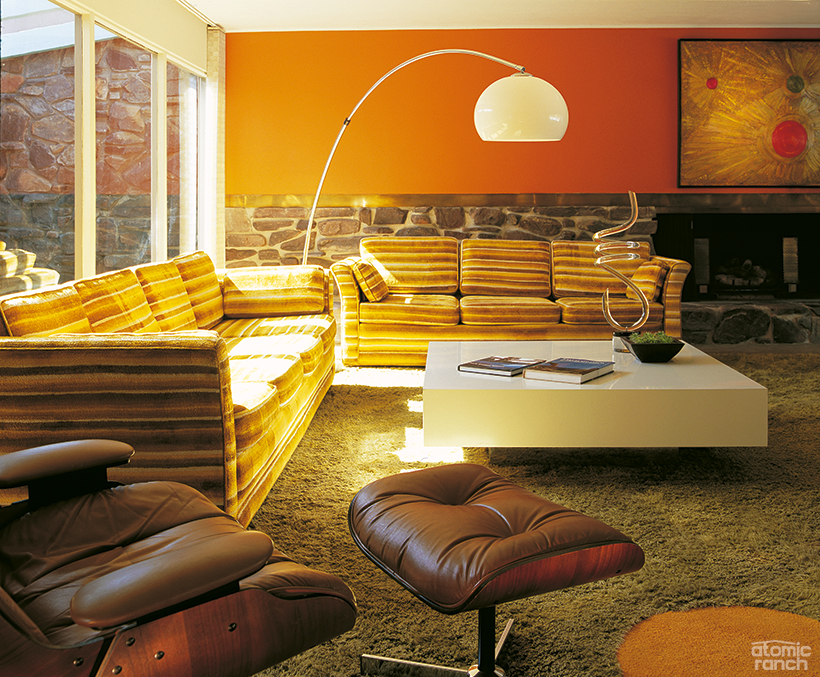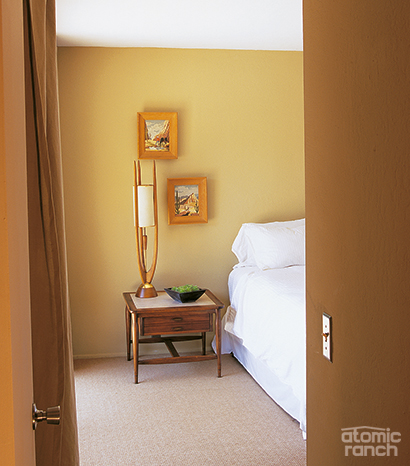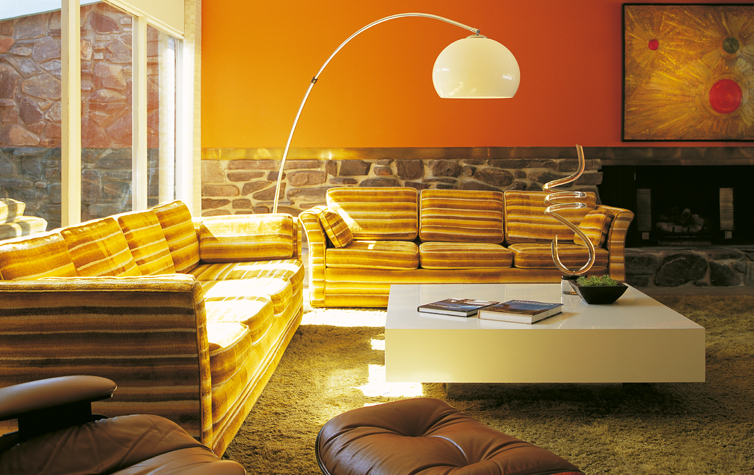
After looking at many Palm Springs homes, Joseph Hahn and David Brinkman successfully locked down their new Jack Webb home (part 1). After stripping it down and shopping a ton on eBay for vintage finds (part 2), their new mission: fill it back up with furniture strictly in proper period style.
Unable to find the 30’-long 1950s sectional they envisioned at any of Palm Springs’ many consignment shops, the couple ended up in a thrift store they term “lower-end than Goodwill.” Buried in a back room was “the” couch, or actually two matching 7’ and 10’ sofas with quintessential striped ’70s upholstery. One hundred dollars and an un-air-conditioned truck move later, the men had the cornerstone of their living room.
That room’s custom-made rug was found at the 2004 Palm Springs Modernism show. At a tough-to-sell 17’ x 17’, the Texas dealer was pleased to find a buyer for both it and the matching 3-D painting from a Dallas mansion. Two white Naugahyde chairs—$200 each—came from Room 107, a vintage store in Pasadena. A couple of bottles of Formula 409 later, the chairs look right in place in the desert aesthetic, their period style shining through.

Brinkman’s aunt Jan, who had a midcentury modern vacation home in Clear Lake, Iowa, donated the arc floor lamp to the couple. In the dining area of the room, eight orange fiberglass chairs came from the University of Tulsa cafeteria and still had their identifying labels. Hahn refinished and reupholstered a Danish modern dining set they picked up at the Pasadena City College Flea Market. It and a $20 yellow ottoman found at a nearby yard sale sit near the bar adjoining their renovated kitchen.
“When we walk into somebody’s house and they have a mix of midcentury and contemporary furniture I like it,” Hahn explains, “but it’s not for me. I prefer sort of living in the period. Some people who are drawn to the midcentury aesthetic don’t have enough imagination to branch out of mainstream choices. They don’t have the courage to develop their own eclecticism within the aesthetic. We lean toward the fun, eclectic and joyous—and perhaps a bit of the kitschy—rather than austere, formulaic or severe.”
Outside, the pool was made shallower and retiled, and all new hardscape installed. The curving planting areas—they don’t really qualify as flowerbeds after all—were freshly populated with cactus and succulents, and mulched with gravel. Their chaise longues, tables and chairs are all vintage, much of it also from local yard sales.
The Sunday we visited, the water pipes in their slab had sprung a leak and plumbers were busily installing a replacement system in the crawl space above the ceiling. It was April and plenty hot already.
“It can be 116 degrees outside, 85 degrees inside with two big air conditioning units going,” Hahn confirms. “I start laughing when I go out. It’s like a joke—it’s just a blast furnace.”
“The pool gets so hot that you can’t use it,” Brinkman adds. Still, the partners, who celebrated their first wedding anniversary during our visit, would consider living in their home full-time but for the lack of job opportunities.
“There’s a tourist economy and a retiree economy, but not much in the way of business,” Hahn explains. In answer to the question of area demographics, he says with a huge laugh, “This neighborhood is the gayest of the gay. It’s a nice feature, but it wasn’t why we were attracted to the house.”
Brinkman adds wryly, “We joke that the local radio station, KWXY, which plays show tunes and big band songs, is playing for the main population—gays and retirees.”













